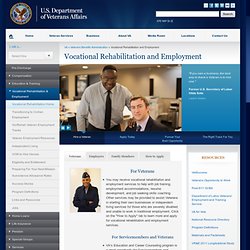

Youth to Work Coalition. The purpose of the Youth to Work Coalition is to provide resources (toolkits, guides, how-to-materials) that link employers and schools to create work-based learning experiences (WBLE) for students with disabilities.

There are eight types of WBLE with resources for different audiences. Below is a table that defines each of the eight areas of WBLE. Click on the side column for your audience, then click the specific WBLE you are interested in learning more about. Once you click on the desired audience, there are various links to the options of: How would WBLE help you? Each WBLE document will link you to a separate page which will address the following questions: How do you do this WBLE?
- ODEP - Office of Disability Employment Policy - Youth in Transition - Soft Skills: The Competitive Edge. Overview "Skills to Pay the Bills: Mastering Soft Skills for Workplace Success," is a curriculum developed by ODEP focused on teaching "soft" or workforce readiness skills to youth, including youth with disabilities.

Created for youth development professionals as an introduction to workplace interpersonal and professional skills, the curriculum is targeted for youth ages 14 to 21 in both in-school and out-of-school environments. The basic structure of the program is comprised of modular, hands-on, engaging activities that focus on six key skill areas: communication, enthusiasm and attitude, teamwork, networking, problem solving and critical thinking, and professionalism. Introduction Materials Soft Skill #1: Communication The activities in this section will not only help participants practice and recognize how they provide information to others, but also help them consider how others may prefer to receive information.
Download Soft Skill #1: Communication (PDF) Choose Work for Service Providers - EN Home - yourtickettowork.com. As of April 16, 2014: IWPs/TARs submitted through April 15, 2014 are currently being processed. (This does NOT apply to eTicket assignment uploaded through the portal) Ticket Holder status in the Portal and IVR is up to date, with the last file processed dated April 14, 2014. Section 503 Regulations are in Effect! Learn about changes to regulations governing Section 503 and how to locate Federal contractors on our dedicated Section 503 webpage located in the Information Center. Section 503 Community of Practice is Wednesday, May 7, 2014 at 3:00 p.m. EST. Topic: Capacity Building and Sharing Click above for more information. Ticket Training Tuesday: April 15, 2014 at 1 p.m.
Topic: The BOND Beneficiary and Wage Reporting All EN Payments Call: Tuesday, April 29, 2014 at 3 p.m. New Tool: Monthly Earnings Estimator! Rehabilitation Research and Training Center on Vocational Rehabilitation (VR-RRTC) Welcome to The SGA Project! National Youth Employment Coalition. Vocational Rehabilitation and Employment Home. For Employers Veterans leave military service with a wealth of transferable skills and professional experiences.

Salary subsidies, assistive technology, tax incentives, non-paid work experiences, and special employer incentives may be available from VA to help you hire those who have served. Explore what VA offers to make hiring or rehiring a Veteran with a service-connected disability that much easier. The Department of Veterans Affairs created a Veterans Employment Toolkit for employers. This toolkit provides a variety of outside resources for employers, managers or supervisors, and human resource provessionals, including information about PTSD and TBI. Find more information for employers. My Next Move. Overview_of_Rehab_Act_and_VR. ICI - WIA and One-Stop Centers: Opportunities and Issues for the Disability Community.
Home : Publications : Institute Brief 13 Originally published: 12/2000 Major changes in the employment and training systems across the country are currently taking place, changes that could have a significant impact on services for people with disabilities.

These changes are a result of the Workforce Investment Act (WIA), a federal law, effective July 1, 2000, which governs how publicly-funded workforce investment and training services operate. The new federally-sponsored nationwide employment and training system established under WIA is called "America's Workforce Network". What are the basic principles of WIA? There are six key principles of WIA: Streamlining services: Multiple employment and training programs are integrated into one system.Universal Access: Every individual, including people with disabilities, has access to basic or "core" services. What does WIA replace? WIA replaces the Job Training Partnership Act (JTPA). No more prerequisites for receiving services. What are ITAs? Voc rehab People With Disabilities on Tribal Lands.